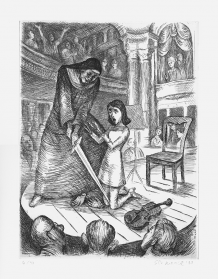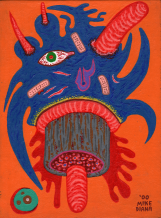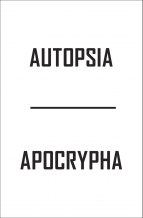| Umělec magazine 2008/1 >> Classic Works Of Aesthetic Theory | List of all editions. | ||||||||||||
|
|||||||||||||
Classic Works Of Aesthetic TheoryUmělec magazine 2008/101.01.2008 Karin Rolle | review | en cs de es |
|||||||||||||
|
The French philosopher Alain Badiou, born in 1937, has written a manifesto of art. After half a century of post-modernist arbitrariness, he calls for new alignment: art has to articulate a specific truth; it has to have a liberating effect.
“We are tired of the end of art. […] Let us proclaim the artistic rights […] to inhuman truth once again. Let us accept once more that we are permeated by truth (or by beauty, which is the same).” This is the clear language of a manifesto that does not baulk at the big questions of philosophy and forcefully presents these to the reader: art has to convey a specific truth, which is the foundation for the emancipation of society. Alain Badiou’s "Third Draft of a Manifesto for Affirmationism," published in the autumn of 2007, was preceded by his "Little Manual of the In-Aesthetic" (2001), the central ideas of which appear in the new publication in trenchant form. Badiou’s thought is based on two premises. Firstly, following a period of endless discourse – a period of the deconstruction of obligatory statements – Alain Badiou pushes the existence of universal models of truth. Secondly, a specific form of truth is represented by art, which according to Badiou takes up a self-contained space alongside science, politics and love. Yet how can we imagine the specific truth of art in concrete terms? Badiou describes the contemporary art scene as the dialectic between the culture industries and a supposedly subversive impulse of formalistic romanticism understood as a post-modern, arbitrary form of art. Whereas culture industries follow the laws of the market and become ever more bombastic, formalistic romanticism thinks it can avoid the laws of circulation. This counter-movement, however, gets lost in a playful repetition of ideas and forms; and thus, the alleged counter-movement to commercialization, Badiou contends, adopts more and more the laws of the market. A new affirmative art must manage to elude the laws of circulation, break up repetitive formalism and thereby describe a specific truth. Even if Badiou’s explanations about affirmative art remain vague, it is clear that he insists on implementing this breaking up of repetition by means of an innovative, formal composition. An affirmative piece of art has to be well-thought-out and consistently made; it has to advance what has already been achieved at a particular time and synthesize it into a universal truth. Following half a century of criticism of universal models of truth, Alain Badiou’s claims come with a bang. They set him apart from the older generation like Michel Foucault, Deleuze or Lyotard. Yet he does not fall back behind these. Alain Badiou does not demand a positive truth. Rather, he takes the uncertainty of truth, which he approaches heuristically, into account. While in the end, truth cannot be identified in positive terms, we have to hold on to the obligation to truth. Badiou’s idea of truth is ontological. Like most French thinkers of the second half of the 20th century, Alain Badiou has been inspired by Heidegger’s ontology. Truth is intertwined with an event; it is an instant in which something new appears. ‘The old’ is recognised as obsolete in a form of negation, in the process of setting boundaries, and outdated arrangements experience an expansion. When Badiou speaks of true art, he first and foremost means language and literature. His theory of art refers particularly to great writers like Stephane Mallarmé, Fernando Pessoa or Samuel Beckett; yet with respect to painting Badiou makes reference to Picasso and, as regards music, to Schönberg. They are the models for a new art which conveys an uncompromising principle and which is logically thought through, composed with precision and consistently arranged. Affirmative art, understood in this sense, does not only herald an artistic revolution, but also manages to formulate a critique of society. It is aimed against the circulation of capitalism and against the undermining of democracy by endless communication. Badiou concludes: “True art is therefore what interrupts the circulation and does not communicate anything.” Badiou’s manifesto of affirmative art has to be understood mainly as part of his political theory. Thus, we cannot just remove his thoughts on art from his work and transfer them on art. Badiou succeeds, however, in articulating a plea for a work of art whose quality is not determined by an "endless discourse about art," but obligatory guidelines. The stakes are high: true art is about societal emancipation —for Badiou, art is truth.
01.01.2008
Recommended articles
|
|||||||||||||
|
04.02.2020 10:17
Letošní 50. ročník Art Basel přilákal celkem 93 000 návštěvníků a sběratelů z 80 zemí světa. 290 prémiových galerií představilo umělecká díla od počátku 20. století až po současnost. Hlavní sektor přehlídky, tradičně v prvním patře výstavního prostoru, představil 232 předních galerií z celého světa nabízející umění nejvyšší kvality. Veletrh ukázal vzestupný trend prodeje prostřednictvím galerií jak soukromým sbírkám, tak i institucím. Kromě hlavního veletrhu stály za návštěvu i ty přidružené: Volta, Liste a Photo Basel, k tomu doprovodné programy a výstavy v místních institucích, které kvalitou daleko přesahují hranice města tj. Kunsthalle Basel, Kunstmuseum, Tinguely muzeum nebo Fondation Beyeler.
|
































 New book by I.M.Jirous in English at our online bookshop.
New book by I.M.Jirous in English at our online bookshop.
Comments
There are currently no comments.Add new comment